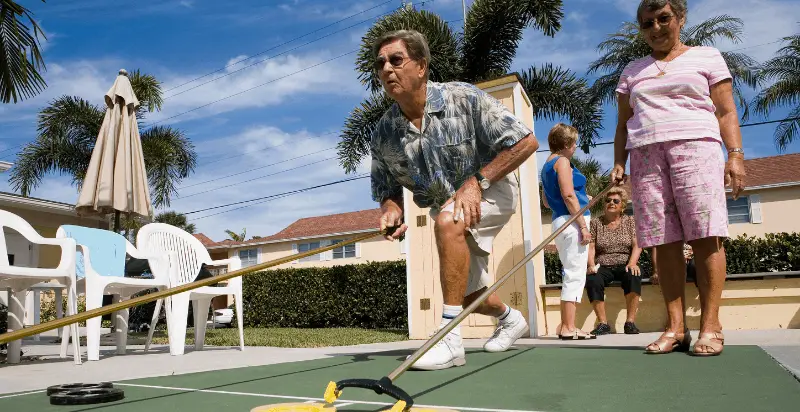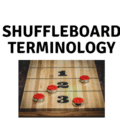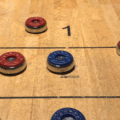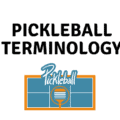Shuffleboard may not be your first choice when it comes to a recreational activity your whole family can enjoy, but why is that?
Do you consider it an activity for retirees? Does it seem boring to you? Does it just not pique your interest?
If you answered “yes” to any of those questions, we’re here to change your mind! We’re going to fill you in on the game’s unique background as well as explain how to play shuffleboard. You never know, you may find yourself a little more interested in this intense, fun, and competitive game after all.
Note: If you are looking to buy a shuffleboard table for home, be sure to see our review of the best shuffleboard tables
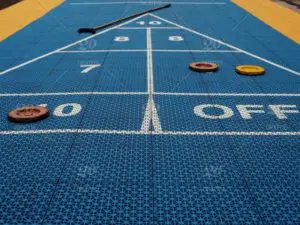 Yes, Shuffleboard
Yes, Shuffleboard
It may seem hard to believe now, but there was a time when cornhole wasn’t one of the fastest growing games in America. Its origins are widely disputed among residents of Cincinnati, Chicagoland, and Kentucky who all claim a stake in the game’s history, each with its own name for the game.
Twenty years ago, a family in Northwest Indiana had to build their own boards and fill their own bags, because they had nowhere else to turn. Today, cornhole is so popular that ESPN covers the Cornhole World Championships and you can buy a set at most big-box retailers.
Shuffleboard may not seem like it could ever be as popular as cornhole but at one point it was just as popular as baseball.
Shuffleboard Has a Long and Rich History
The earliest recorded game played was in England in 1532. At the time, the game was “shove-groat” because you played by shoving a coin, called a groat, down a table.
It began as a parlor game among royals but its popularity spread across the country. Eventually, it made its way to the New World and colonists played with such fervor that Arthur Miller referred to players of shuffleboard as “ne’er-do-wells” in his play The Crucible, which took place in the Massachusetts Bay Colony during 1692.
Shuffleboard reached such a fever pitch in the U.S. that 196 defendants went to court in 1848 over it. In State Vs. Bishop, the North Carolina Supreme Court ruled it was a game of chance, not a game of skill.
During the 1940s, shuffleboard grew to a national sport and a decade later, competitions began sprouting up across the U.S. Some had as many as 575 teams competing.
Over the next 20 years, its popularity declined. Some folks believe it was due to American football taking over television sets while others believe it was a lack of organization that caused shuffleboard’s downfall.
In the 1990s, a resurgence began, although there have always been pockets of shuffleboard lovers and clubs to support it. And you now have some insight into why it’s so popular among the 60-year and older crowd!
How to Play Shuffleboard
There are two main variations of shuffleboard: table shuffleboard and outdoor shuffleboard.
Both involve a longboard and discs, often called pucks. The goal is to get your discs to the furthest point of the board without going over the edge or crossing the end line.
There are also three ways to do this:
- Well-Placed Puck – This takes the most skill. This involves sliding your puck to the other end of the board and having the precision to land it on the highest number.
- Attacking Opponent’s Puck – Is another’s player’s puck in your way? Move it by bumping it out of your way.
- Blocking/Protecting Puck – If you have a disc on a high score, use your other discs to block or protect it on your other turns.
In both versions, you can play with two people or four, also called a team. When playing with two people, each player gets all four discs of the same color. They stand at the same end of the board and take turns going back and forth until the game is over.
When you play with four people, two people make up a team. Each team gets four pucks, but in this case, one player from each team stands at either side of the board and the players alternate sliding the discs.
Here’s where the two differ…
Table Shuffleboard Rules
Over the last few years, table shuffleboard has made a resurgence, mostly in taverns and bars. The table shuffleboard service is much smaller than an outdoor court, measuring anywhere from 12 to 22 feet long.
If the table isn’t already marked, players draw lines at six and 12 inches from the end of the table. A foul line is also drawn six feet from the end of the table, which represents the line the disc must cross in order to be kept in play.
Scoring is marked by three numbers: 1, 2, and 3. The 2 is drawn on the table from the 6-inch line to the end. The 2 is drawn on the table between the 6-inch and 12-inch lines. The 1 is marked between the 12-inch line and foul line.
Yes, it’s pretty easy to score 1 point; all you have to do is slide the disc with your hand across the foul line. Pretty easy, right?
If a disc hangs over the end of the table but doesn’t fall, it’s scored as a 4. If a disc lands on a line, it’s scored as the lower number. The first person/team to 21 points wins.
Outdoor Shuffleboard Rules
When you think of the movie Cocoon or any other senior playing shuffleboard, the outdoor version is probably what comes to mind. But this version can be just as competitive and intense as the table version.
The outdoor shuffleboard court is a 52-inch long rectangle with two large triangles drawn on each end. In most cases, the triangular scoring areas will already be marked, but in case they aren’t, the tip of the triangle is marked with a 10.
Under the 10, six sections are created by drawing a line dividing the rest of the triangle in half. The two boxes under the 10 is drawn with 8’s, followed by 7’s in each box under the 8’s, and finally, a 10 and “off” are marked on the bottom boxes, or at the base of the triangle.
Players are each given a cue with a u-shaped prong at the end, where the pucks fit. Each player/team picks a color: Yellow, which always starts on the left side of the board at the 10-off square and black, which starts on the right side.
The puck has to cross an area called the “deadline” 3 feet from the opposite scoring triangle. If a puck fails to cross the deadline, it’s removed from the court.
The goal is to have your pucks land on the highest values by sliding it with a cue or bumping it with another puck. Whoever reaches 75 points first wins.
Unlike table shuffleboard, the outdoor version assesses penalties for breaking the rules. If a puck touches the 10-off area, five points are added to their score. 10 points can be added to a player’s score for a puck that touches the triangle’s side when it rests and if a player’s body crosses the baseline on a shot.
The most important thing about both table shuffleboard or the outdoor version is to have fun!
What Are You Waiting For?
At Real Hard Games, we consider ourselves “Master of all games, Jack of none” and strive to get you the information you need so you can appreciate sports that may not be on your radar.
Just like how we explain the fundamentals in our “How to play shuffleboard guide,” we also provide info on other activities, as well as product reviews of everything from foosball tables to dart boards.
If you find yourself playing more shuffleboard, it’s important to know the lingo and shuffleboard terminology – it will make you sound better and eventually it will help you play better –
If you have a question about a particular sport or product, drop us a line, we’d love to hear from you!

I’m Lia and I love playing games. I started this site to share things with friends and they encouraged me to post more and now I’m trying to share things with the world – indoor and outdoor sports, and board and bar games. I write about things like Bocce, Croquet, Billiards, Darts and other fun ways to enjoy time with your friends and family!

